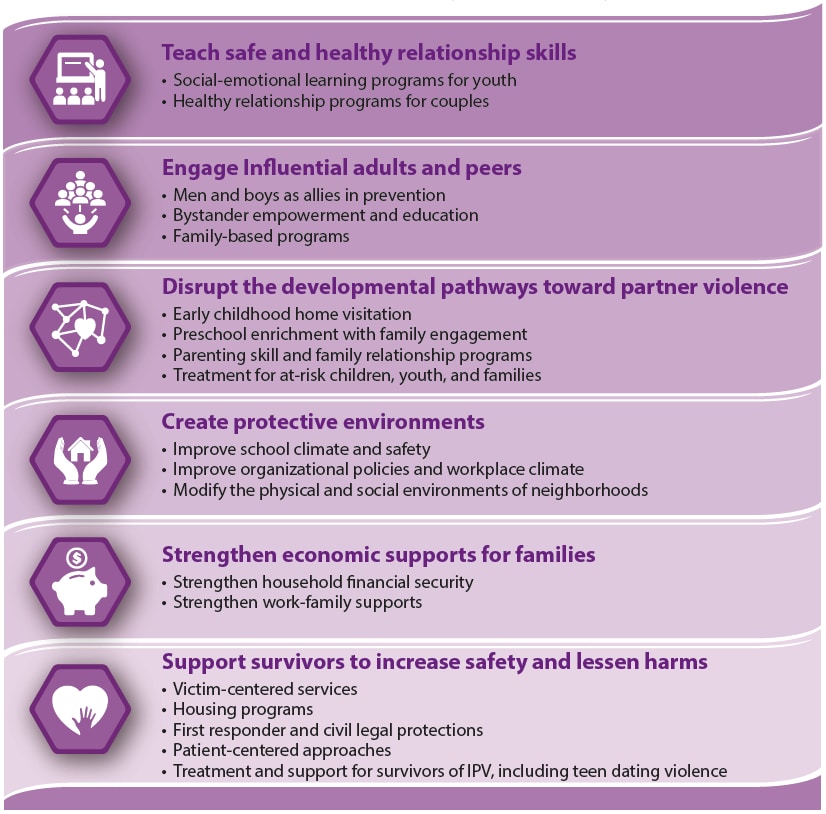
Domestic Violence Awareness Month – October

Preventing Intimate Partner Violence
Source: Centers for Disease and Control (CDC)
What is intimate partner violence?
Intimate partner violence (IPV) is abuse or aggression that occurs in a romantic relationship. “Intimate partner” refers to both current and former spouses and dating partners. IPV can vary in how often it happens and how severe it is. It can range from one episode of violence that could have lasting impact to chronic and severe episodes over multiple years. IPV can include any of the following types of behavior:
- Physical violence is when a person hurts or tries to hurt a partner by hitting, kicking, or using another type of physical force.
- Sexual violence is forcing or attempting to force a partner to take part in a sex act, sexual touching, or a non-physical sexual event (e.g., sexting) when the partner does not or cannot consent.
- Stalking is a pattern of repeated, unwanted attention and contact by a partner that causes fear or concern for one’s own safety or the safety of someone close to the victim.
- Psychological aggression is the use of verbal and non-verbal communication with the intent to harm another person mentally or emotionally and/or to exert control over another person.
IPV is connected to other forms of violence and is related to serious health issues and economic consequences. However, IPV and other forms of violence can be prevented. For more information about intimate partner violence definitions please see Intimate Partner Violence Surveillance: Uniform Definitions and Recommended Data Elements, Version 2.0. pdf icon[3.04 MB, 164 Pages, 508].How big is the problem?
IPV is common. It affects millions of people in the United States each year. Data from CDC’s National Intimate Partner and Sexual Violence Survey (NISVS) indicate:
- About 1 in 4 women and nearly 1 in 10 men have experienced contact sexual violence, physical violence, and/or stalking by an intimate partner during their lifetime and reported some form of IPV-related impact.
- Over 43 million women and 38 million men have experienced psychological aggression by an intimate partner in their lifetime.
IPV starts early and continues throughout the lifespan. When IPV occurs in adolescence, it is called teen dating violence (TDV). TDV affects millions of U.S. teens each year. About 11 million women and 5 million men who reported experiencing contact sexual violence, physical violence, or stalking by an intimate partner in their lifetime said that they first experienced these forms of violence before the age of 18.

What are the consequences?
IPV is a significant public health issue that has many individual and societal costs. About 35% of female IPV survivors and more than 11% of male IPV survivors experience some form of physical injury related to IPV. IPV can also result in death. Data from U.S. crime reports suggest that about 1 in 5 homicide victims are killed by an intimate partner. The reports also found that over half of female homicide victims in the U.S. are killed by a current or former male intimate partner.
There are also many other negative health outcomes associated with IPV. These include a range of conditions affecting the heart, digestive, reproduction, muscle and bones, and nervous systems, many of which are chronic. Survivors can experience mental health problems such as depression and posttraumatic stress disorder (PTSD) symptoms. They are at higher risk for engaging in behaviors such as smoking, binge drinking, and sexual risk behaviors.
Although the personal consequences of IPV are devastating, there are also many costs to society. The lifetime economic cost associated with medical services for IPV-related injuries, lost productivity from paid work, criminal justice and other costs, was $3.6 trillion. The cost of IPV over a victim’s lifetime was $103,767 for women and $23,414 for men.
How can we stop it before it starts?
Promoting healthy, respectful, and nonviolent relationships and communities can help reduce the occurrence of IPV. It also can prevent the harmful and long-lasting effects of IPV on individuals, families, and communities. CDC developed a technical package, Preventing Intimate Partner Violence Across the Lifespan: A Technical Package of Programs, Policies, and Practicespdf icon[5 MB, 64 Pages, 508], that includes multiple strategies and approaches to prevent IPV. It also includes approaches that provide support to survivors and lessen harms. The strategies and approaches are meant to be used in combination with each other at many levels of society to prevent IPV.

For more information about IPV, SV, and Stalking among Men, please see Intimate Partner Violence, Sexual Violence, and Stalking Among Men.
For information about SV and IPV among people with disabilities, please see Sexual Violence and Intimate Partner Violence Among People with Disabilities.
Event Attendees
No attendee found! Be the first one to book!







Responses